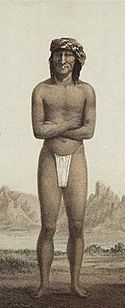Cairook facts for kids
Quick facts for kids
Cairook
|
|
|---|---|
|
A rendering of Cairook by
Balduin Möllhausen, c. 1857 |
|
| Mohave leader | |
| Preceded by | Unknown |
| Succeeded by | Irataba |
| Personal details | |
| Born | Unknown Alta California, New Spain |
| Died | June 21, 1859 Fort Yuma, California |
| Cause of death | Killed by US soldiers while trying to escape imprisonment |
| Known for | navigational prowess, leadership of Mohave people |
Cairook, also known as Avi Havasuts ("Blue Rock"), was an important leader of the Mohave people. He was born before 1814 in a region that is now part of California. Cairook was known for his strong leadership and his skill in guiding people through the land.
Contents
Cairook's Role as a Guide
In 1854, Cairook helped the Whipple expedition. He guided them from the Colorado River through the area now called the Mojave National Preserve. Amiel Weeks Whipple, the expedition leader, was thankful for Cairook's help. He found Cairook to be an honest and fair trader.
Explorers Admire Cairook
Many American explorers admired Cairook. Charles Ives wrote in his journal in 1858 about Cairook's "noble appearance." Ives noted that Cairook wished them a good trip. He watched them leave, waving goodbye. The explorers felt sad to part with him. They saw him as a true friend. According to a book called Mohave People, Cairook was very tall, nearly 6 feet 6 inches (198 cm).
Events Leading to Conflict
In 1858, an event involving the Rose-Baley Party led to serious problems for Cairook. This group of travelers arrived near the Colorado River in August 1858. L.R. Rose, one of the leaders, said the Mohave people were very friendly. They helped the tired travelers.
The Rose-Baley Party Incident
On August 29, Mohave leaders Cairook and Sickahot visited the travelers. They asked if the group planned to settle on Mohave land or just pass through. The next day, August 30, the traveling party was attacked. This happened after they cut down many Mohave cottonwood trees. They also let their cattle graze on Mohave territory. The remaining members of the Rose-Baley Party quickly left the area.
Military Response and Demands
After the attack, General N.S. Clarke, a military commander, decided to build a military post. This post was to be at Fort Mojave. He believed it would prevent a larger uprising by Native American tribes. General Clarke sent Lieutenant Colonel William Hoffman with 50 soldiers. Their mission was to build a fort near the Colorado River. This fort would help the US military control the area.
Hoffman's Warning to the Mohave
At first, the soldiers and Mohave people met peacefully. However, the continued presence of soldiers worried the Mohave. They felt the soldiers were taking over their fertile land in the Mojave Valley. After initial friendly meetings, Hoffman warned the Mohave to stay away from his camp at night. He said they risked being shot. He then moved his camp closer to the Colorado River.
One night, Hoffman reported that his guards shot at several Mohave and Paiute people. He wrote that the tribes' actions made him believe a fight was unavoidable. He felt they could not stay in the valley much longer without a conflict.
Hoffman's Demands
Hoffman decided to attack the Mohave the next day. At least ten Mohave people were killed. Hoffman and his group then went to Fort Yuma. They planned to gather more soldiers to return to Mohave territory. Hoffman demanded that the Mohave tribe surrender to US forces. He listed several conditions in a letter in April 1859:
- The Mohave must not stop the US government from building forts and roads in their country.
- The lives and property of white travelers must be safe.
- The Mohave must give one hostage from each of their six groups.
- They must hand over the chief who led the attack on Hoffman's camp in January.
- They must also hand over three people involved in the attack on the emigrant party last summer.
Cairook's Imprisonment and Death
Cairook was one of the Mohave leaders who agreed to be taken hostage. He was held by the US government at Fort Yuma. By late June, the imprisoned Mohave were tired of being held. Irataba, another Mohave leader, visited to ask for Cairook's release. When this request was refused, Cairook and the other hostages planned to escape.
The Escape Attempt
Cairook's part in the escape plan was to hold the guard. While he did this, the other prisoners tried to get away. During this attempt, Cairook was killed by a bayonet. According to Frances Stillman, a Mohave elder, Cairook told the younger men, "You're all young. I'm years ahead of you. I've had a lot of years already that I've spent of my life. When its lunch time, all the guards go to their lunch except that one up there. I'll go up and hold him while you men dive into the water."


